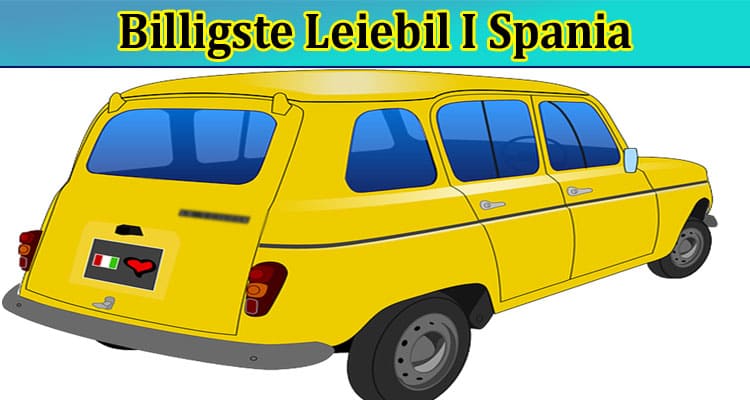Enthusiastic travelers will be familiar with the advanced bus and railway system Spain is renowned for. Still, the country can only be appreciated when driving the scenic roadways. When renting a car, visitors can design their own itinerary and take it leisurely. Read here for tips on car rentals in Spain.
The roads overall are maintained relatively well, stretching every edge of the country. A guest has the opportunity to see the sea one day and wander the mountaintops the next with large cities, including Barcelona, filling in any potential downtime.
A car will take you wherever you want to go allowing you to see whatever you want to capture. How do you rent a car in Spain? Is it an easy process or challenging for visitors from other countries? Let’s learn.
How Can You Prepare For A Car Hire In Spain
The recommendation from people experiencing the loveliness of Spain is that you should do so using a rental car. Check this website, leiebilguiden.no/spania, for a guide on rental cars in Spain. It allows you to set your own agenda and pace that schedule at your leisure.
Within a matter of a couple of days, you can see the glory of the ocean and majestic mountain tops, plus experience the nightlife of the big cities. There’s never a shortage of things to do, but you can run out of holiday hours, making it necessary to book another trip so you can pick up where you left off.
While renting a car is ideal for seeing the countryside, the process can often be complex, especially when trying to navigate the process in a country that’s not native to you. What’s it like to hire a car in Spain? Let’s look at a few questions and fill in the blanks.
1. What is required when renting a car in Spain
Travelers to Spain will need to bring documentation including the following:
- International Driver’s Permit
- Credit card issued in your name
- Passport
- Driving license from home country
The country’s legal driving age is 18, but in order to rent a vehicle, the agencies in Spain require motorists to be at least age 21 with roughly one year of driving experience. Some are stringent about age, with the requirement set at age 23 to hire a car or over.
To pay the invoice, each driver must show a valid driving license with proof of ID and a credit card issued in their name. If the renter is under 25 years of age, most rental companies in Spain will attach an added fee.
For non-EU citizens, an International Driving Permit is mandated by law for those who intend to drive in the country. The rental agency will expect to see this, and the police will ask for this if you’re stopped.
These cost $15 in US currency with validity for a year. These can be arranged in your home country.
2. The Spanish guidelines for rental car insurance
A Spanish rental car must have unlimited third-party liability coverage. Most rental agencies provide this in the price of the car hire. This will show on your credit card as a “deductible hold.” You’ll need to ensure your credit card can cover the deposit before attempting to hire a car.
There is a recommendation for Collision Damage Waiver (CDW) for additional insurance as well as theft coverage, but these are not required. When driving in Spain, you are expected to have the car’s documentation, proof of insurance coverage, IDP, and passport.
If the car displays a rental sticker, it’s essential to remove this or ask the rental company to remove it. These stickers are known to attract thieves in the country.
What Tips Should You Follow Upon Renting A Car In Spain
Once you book a car, you must do the final paperwork and pick up the rental. There are a few tips to follow to protect yourself and the company. Consider these suggestions.
1. Inspect the car on the interior and exterior
When you pick up a rental car in Spain, you must inspect the vehicle inside and out. If you’re visiting in winter, ensure the car is fitted with adequate snow tires or snow chains in the trunk.
The provider will give you a checklist to designate any sort of dings, scratches, or damages you take note of. If the damage isn’t listed, report the issue and make a special note on the form before signing off. The mileage and fuel gauges at the time of pickup will be noted as well.
In order to be entirely thorough, it’s wise to shoot a video or take photos of the damages discussed and the mileage and fuel.
2. A smaller rental might make more sense
When motorists drive in Spain, smaller cars are more conducive to the narrow streets, small parking spaces, plus the premium cost of gas. Unless you need the extra room or plan to spend much of the time in mountainous regions, it’s wise to stick with a more compact car.
Much of the history is still evident, including the narrow cobblestone town and village roadways. It can be difficult to maneuver along these paths even in a small vehicle, plus attempt to follow a navigation system with the road signs and not get a ding, scratch, or other damage to the car.
3. Parking in Spain is challenging
The urban areas in Spain can present a challenge regarding parking, particularly in the “ancient centers.” The rules in the different regions throughout the varied cities are distinct for that location.
Blue lines on the curb designate paid street parking with tickets available for purchase in machines located close to the parking zones.
Residential parking spots are marked in either green or a black sign with a “P” printed on them. Typically, on Sundays and national holidays, street parking is free, and then usually in urban areas after 7 pm, but it’s wise to verify those details to prevent the chance of a fine.
One thing to be mindful of when parking is that a lot of the motorists are not too concerned about receiving a dent or scratch with their car. It’s relatively common for drivers to “bump” other vehicles out of their way if a driver feels it will make their parking simpler.
You should always pay attention to the areas where you park and not keep personal items on display in the vehicle. Baggage, valuables, and anything important should be removed to avoid the possibility of theft which is rampant among rental cars.
Final Thought
The price for renting cars in Spain boasts of being relatively reasonably priced. The cost depends on a few variables, including the season you’re visiting, how long you’ll stay, and the car type you request.
The summer months are a busy time for travelers and tourists in Spain, making the demand higher for car rentals, thus driving up costs. The rest of the year sees fewer visitors, especially during the winter, at which point the rental fees are much lower.
If you rent for a longer duration, that will impact the daily rate favorably, meaning if you rent for a week, you’ll only pay slightly more than what you would pay for roughly a three-day visit. Planning for at least a week’s stay is wise when traveling and using car rental services.
You’ll find there are a number of reputable car hire agencies in Spain to choose from. Each is ready to set you up for your holiday excursion. There are minimal requirements to qualify for a rental.
The main priority is to adapt to the road regulations and other motorists’ habits . . . and perhaps adjust to driving a stick shift.








